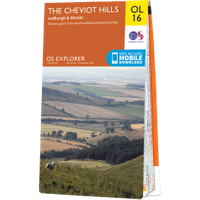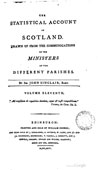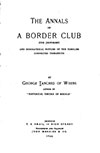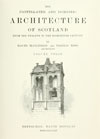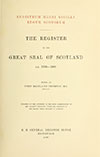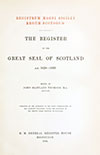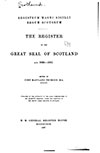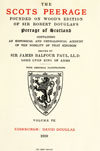

Cessford Castle is a massive L-plan tower house which dates to the 15th century and was the seat of the Kers of Cessford but it is now a substantial ruin.
The castle was one of the major strongholds guarding the Middle Marches of the Borders and stands on a ridge which rises between the Cessford Burn to the west and the Tanlaw Burn to the east and affords extensive views across the Cheviots to the south.
The name appears in early records as variants of both Cessford and Cessworth, both containing the Old English word cess meaning “bog” with the former meaning a ford or crossing over the bog and the latter suggesting an enclosed homestead on or by the bog. Certainly the partly-boggy ground of Cessford Moor stretches out to the south-west of the castle.
The barony of Cessford was located to the south-east of the manor of Eckford and seems to have consisted all the lands between it and Whitton. Its early history doesn’t seem to be known however by the late 12th century it was in the possession of Sir Robert Oliphant of Cessefoord. Sir Robert’s daughter, Elizabeth Oliphant, married Sir John Somerville of the neighbouring barony of Linton, son of Roger de Somerville.
By the mid-13th century Cessford was part of a large swathe of land bounded by the Teviot to the west and the Kale to the north and east and owned by Geoffrey of Ekkeford, better known as Sir Geoffrey de Mowbray, Justiciar of Lothian. Sir Geoffrey died in 1300 and was succeeded by his third son, Sir Roger de Mowbray, however Sir Roger was involved in a plot to kill Robert the Bruce and replace him as King with William de Soules, Lord of Liddesdale. He was wounded during his arrest in 1320 and died in prison while awaiting trial.
Sir Roger’s extensive estates were forfeited to the Crown, and Robert granted the demesne lands of Cessworth to Edmond Marshall or Edward Marshal and the remainder of the lands of Cesseworthe and the mill to William de St. Clair of Hirdmenston. In 1326 the King gave £2000 Sterling for the rebuilding of Melrose Abbey following its destruction by the English in 1322. The money was primarily raised from the baronies of Cessford and Eckford which Sir Roger de Mowbray had forfeited, and the lands of Nisbet, Longnewton, Maxton and Caverton which William, Lord Soules, had forfeited.
William de St. Clair’s grandson, John de St. Clair of Herdmanston, resigned Cessford to his brother, Sir Walter de St. Clair, in 1376 and Robert II granted Sir Walter a charter of the same on the 8th of March of that year. Sir Walter’s daughter and heiress, Christian, married Sir William de Cockburn of Scraling, and Cessford passed into the Cockburn family.
Their son was styled Alexander Cockburn of Skraling and Cessford and his sons, Adam and William, used the same geographical indicators. This may have related to the superiority of the barony however as later in the 14th century Cessford seems to have been owned by the Ker family.
John Ker, of the Forest of Selkirk, is described as the founder of the house of Cessford and Roxburgh, although he doesn’t seem to have owned Cessford, and is on record in 1358. John’s son, Henry, is on record in 1361 and in 1381 Henry’s son, Robert Ker of Cessford, presided over a council at Jedburgh which recognised John Somerville as heir to his father, Walter Somerville, in the baronies of Linton and Carnwath. The same Robert, seemingly the first Ker to be designated “of Cessford”, received a charter of the lands of Auldtonburn from Archibald Douglas, 4th Earl of Douglas.
Cessford Castle seems to have been in existence in some form by April 1390 as in that month Sir Robert Ker of Cessefoord invited his “cousin”, John, Baron of Carnwath, to dinner at the castle when John was in the area arranging his affairs regarding his barony of Lintoune. During the dinner they learned of the death of Robert II. A splayed course of masonry at the base of the castle, most visible at the south-west corner, may represent work from this earlier castle pre-dating the rest of the tower.
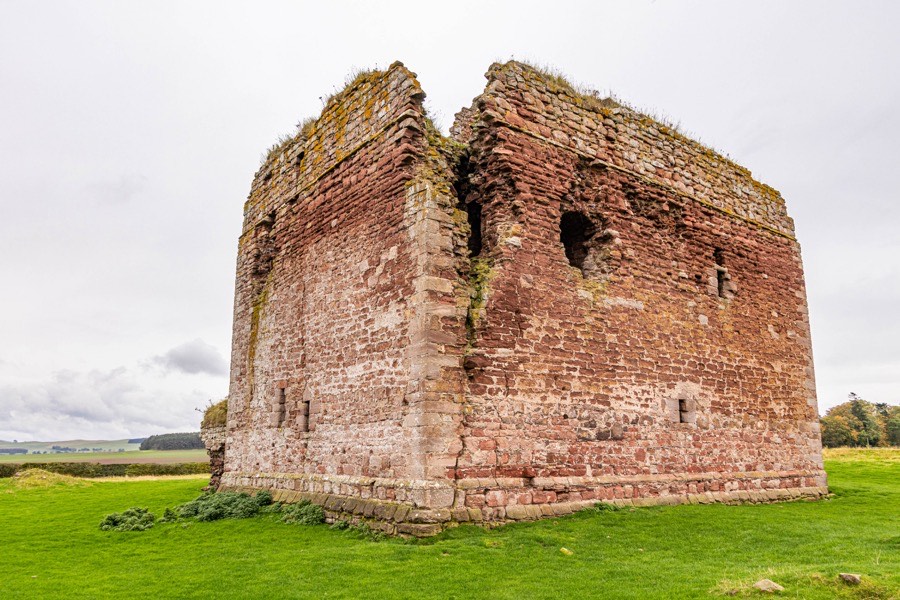
In March 1416 Sir William de Cockburn of Skraling, complained to the General Council of Robert Stewart, 1st Duke of Albany, that he and his wife, Christian, were unable to take possession of the barony of Sesworth as Sir William de Douglas de Aldroxburgh claimed to own the superiority of the barony.
The Douglas family were overlords of all Teviotdale at the time that Robert the Bruce granted the forfeited lands of Cesseworthe to William de St. Clair of Hirdmenston. The Lords of Council studied the charters of infeftment from the reigns of Robert I and Robert II and confirmed that the superiority of the barony was rightly owned by the Sinclairs and therefore subsequently by the Cockburns.
While the Cockburns owned the superiority of Cessford it was held from them by the Kers and it was almost certainly they who were responsible for building the castle in its current form, probably between 1425 and 1450. Andrew Ker of Cessford and Altonburn, second son of Robert Ker, is on record in the early 1440s but died in 1444 and was succeeded by his son, also Andrew, who in 1446 was granted a charter of the barony of Cessford by William Douglas, 8th Earl of Douglas.
Built on an L-plan, the main block is aligned approximately north to south and measures around 19.4m long by around 13.8m across. A wing projects around 6.7m from the south end of the east wall and measures around 11.0m north to south. The tower was built to be exceptionally strong and the external walls, constructed from roughly-coursed blocks of red sandstone interspersed with buff-coloured sandstone blocks and coarser purplish stone, average 3.9m in thickness.

Originally the main block consisted of a vaulted basement with entresol, a vaulted Great Hall and at least one further storey above. The wing is thought to have originally contained at least six lower storeys, with three of them vaulted.
The tower was entered by a pair of doorways in the re-entrant angle, both of which were protected by a corbelled bretèche. The lower entrance at ground level is in the east wall of the main block and was secured by two doors, one opening outwards and the other inwards. It leads into a passageway within the thickness of the wall which gives access via two further doors and a round-arched, chamfered doorway to a wooden-ceilinged storeroom occupying the full length of the ground floor and lit by single slits in the north and south walls.
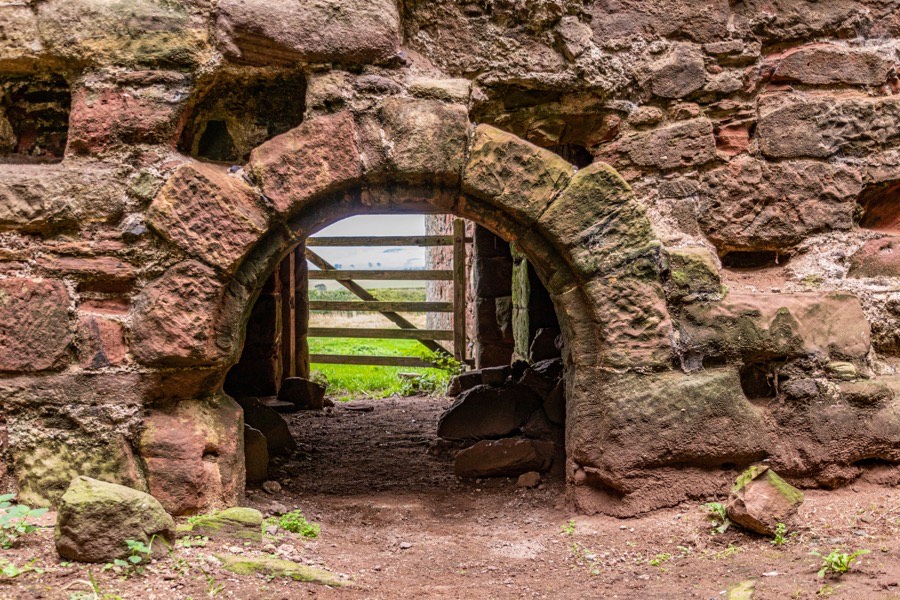
The niches for the entresol’s joists are still visible.
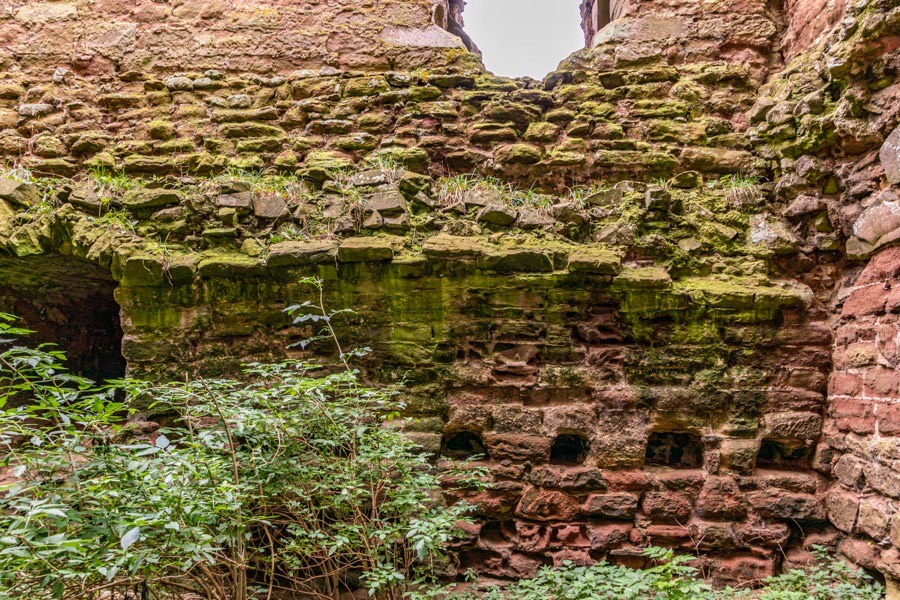
In the middle of the south wall of the passageway a doorway gives access to a narrow, angled corridor off which is a spiral staircase within the thickness of the main block’s wall leading to the upper levels. A gunloop on the north side of this corridor covers the ground floor entrance. The corridor leads to two small vaulted chambers, each lit by a single slit, with the smaller, northernmost one featuring another gunloop covering the entrance. These two chambers may have been guard rooms.
A third small vaulted chamber at this level, within the thickness of the main block’s wall to the south of the staircase, was an unlit pit-prison and was inaccessible on this level, being entered via hatch in its ceiling. The top of the pit-prison’s vault is around 0.9m above the neighbouring guard room’s floor level and the floor of the pit-prison was estimated to be 1.8m to 2.1m below the floor level of the guard room but was full of rubble by the 19th century.
The aforementioned spiral staircase leads up to the entresol level of the basement storey. In the main block was further storage under the barrel vault, lit by slightly larger slit openings in the north and south walls and a small window in the west wall. In the wing was a single vaulted chamber running eat to west over the pit-prison and guard room below. In the floor of this chamber at its western end is the hatch into the pit-prison, and the chamber may have served as a prison or further guard room.
The spiral staircase carries on up to first floor level where it is crossed by a dog-leg arched passageway leading from the upper entrance. This entrance, in the north wall of the wing, is some 5.0m above ground level and would have been reached by a timber forestair. It was also secured by two doors, again one opening outwards and one inwards with the latter further secured by a sliding bar.
To the west of the staircase a doorway gives access to the Great Hall which occupies the whole of this storey in the main block, measuring around 12.2m long by around 6.7m across, with the barrel vault rising to a height of some 6.1m.
The Great Hall was well-lit by four windows. One in the south wall with a window seat, one in the east wall also with a window seat and two in the west wall, the northernmost one of which has a window seat. In the centre of the north wall is a fireplace featuring a canopied chimneypiece with carved cusps over moulded jambs and bases.

Either side of the fireplace is a vaulted intramural chamber, both of which are entered from their neighbouring window embrasures, with the floors of the chambers one step up from the level of the window seats. The easternmost chamber was a latrine while the western one may have been a closet. A further intramural chamber at the south-west corner of the hall is entered at the hall’s floor level. At the southern end of the east wall of the hall a service hatch opens into the kitchen which was contained in the wing. To the west of this on the south wall of the hall is a doorway which leads into a small spiral staircase giving access to a chamber above the kitchen.
Returning to the main spiral staircase a doorway off its south side leads into the aforementioned barrel-vaulted kitchen housed within the wing. Measuring around 6.1m east to west by around 4.1m north to south it features a wide fireplace in the south wall with an oven off its south-east corner and an aumbry with pointed arch surround to its west. The kitchen was lit by a single deeply-splayed window in the east wall.
Above the kitchen was a well-appointed chamber accessed from both the main staircase and that in the south-east corner of the Great Hall. This may have been the accommodation for the Keeper of the Castle. In the north wall, above the castle’s upper entrance, is a window featuring stone bench seats and a cupboard off the east wall of its embrasure. There is a second window in the east wall of this chamber and a canopied fireplace on the south wall. Also on the south wall is a doorway opening into a corridor which leads to the small spiral staircase that descends to the south-east corner of the Great Hall. Off this corridor to the east is a curving passageway leading to a latrine contained within the thickness of the south wall of the wing.
Later remodelling of the upper floors of the castle has obscured their original form however it is likely that there was a further hall and chamber for the laird above the Great Hall, with two further floors providing accommodation in the wing.
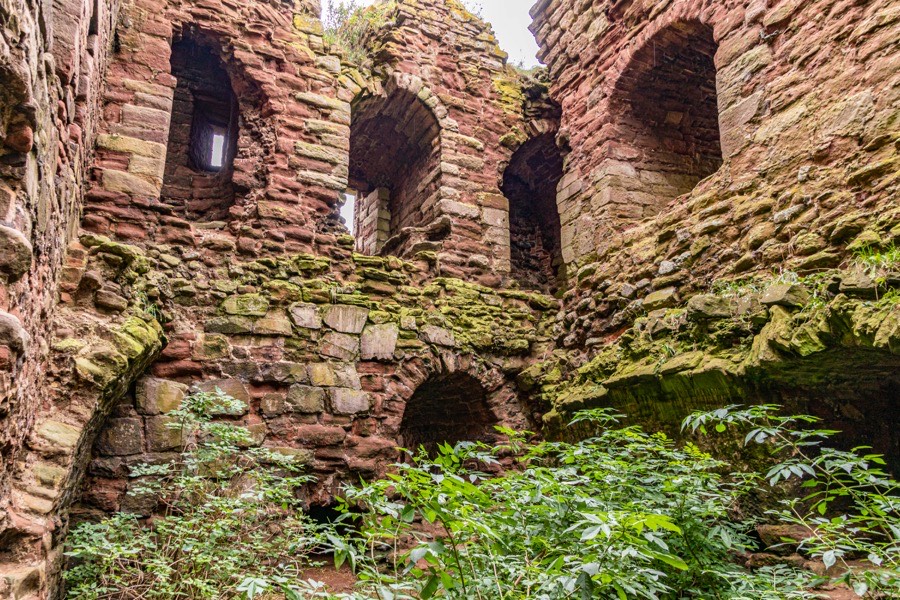
The castle was originally surrounded by wall enclosing an approximately rectangular area measuring around 66.0m north to south by around 73.0m east to west. Around this wall was an earthen bank encircled by a an outer ditch which some sources state was a moat fed by a spring above the farmhouse around 400m to the south.
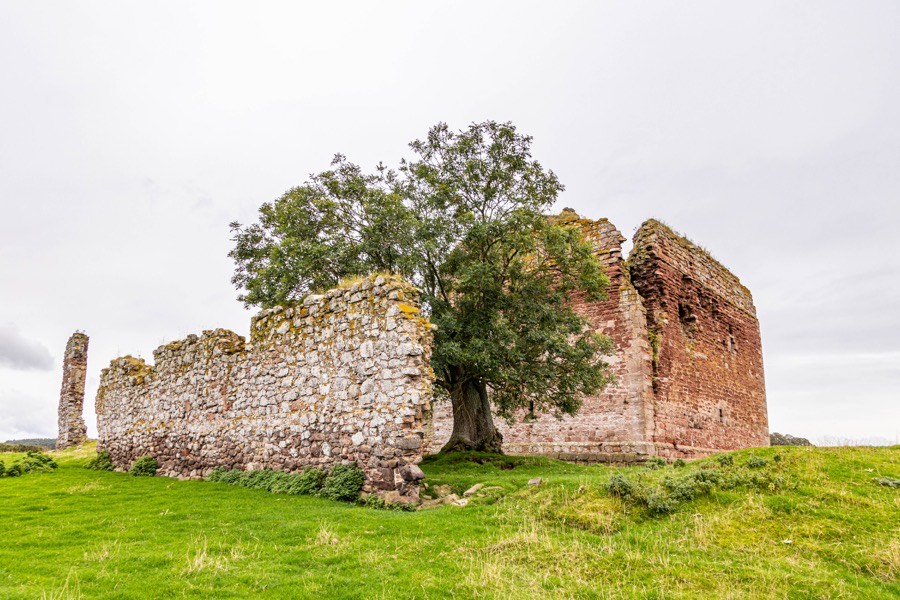
Only relatively small sections of the outer wall survives, the stone having been used for local building work. What has survived, to the north of the castle, seems to have formed part of a two storey range built up against the inside of the courtyard wall. A moulded window jamb may date this range to the late 16th or early 17th century.
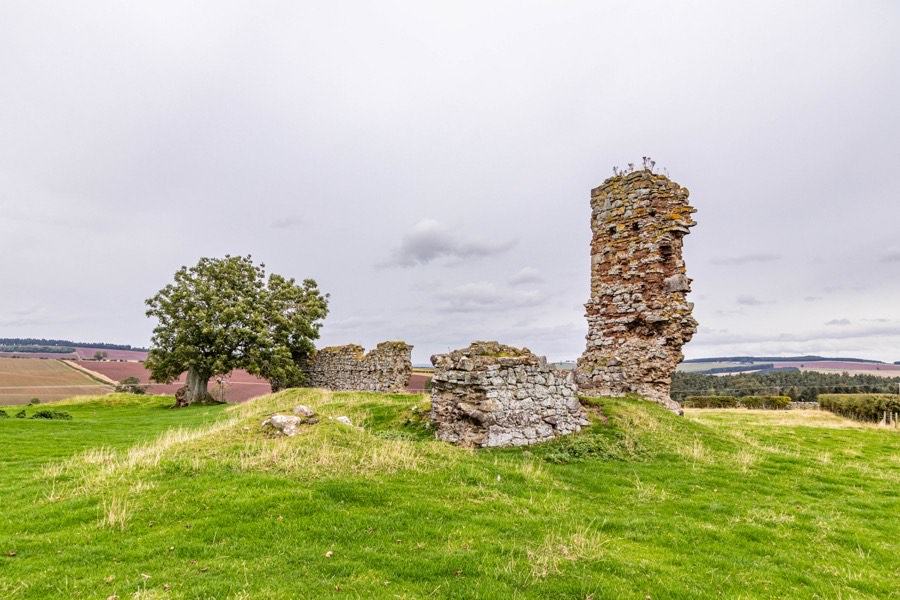
Andrew Ker of Cessford and Auldtounburn married a daughter of William Douglas of Cavers, Sheriff of Roxburgh, and accompanied William Douglas, 8th Earl of Douglas, on his pilgrimage to the jubilee in Rome in 1450. He served as Warden of the Middle March from 1457, protecting Scotland’s border with England, a position that would be held by several generations of his descendants. In July 1466 Andrew was involved in a plot by Sir Alexander Boyd to kidnap the young James III however he was later forgiven for his involvement and in 1467 received a new grant of Cessford from the King.
Andrew resigned the barony and castle of Cesfurde, the lands known as Huntterisland in the lordship of Cavertoune, the barony of Auld-Roxburgh, the lands of Altonburne, the lands of Prymysside, 18 husband lands in the villa and territory of Smalehame, and the 20 merk lands of Cesfurde into the hands of the young James III in April 1474 and they were re-granted to Andrew’s son and heir, Walter Ker of Caverton. Walter was married to Isabel Hay, daughter of Sir John Hay of Yester.
In March 1482, in anticipation of an invasion from England, James III ordered that Cesfurde be garrisoned with sixty men, and Ormystoun’ and Egarstoun’ (Edgerston) with twenty men each, with the laird of Edmonstoun’ appointed captain and ordered to choose the hundred men and two deputy captains.
Andrew was dead by August 1484 but Walter was seemingly running the family’s affairs long before his father’s death. In 1488 Walter received a new grant of the barony and castle of Roxburgh from James IV.
In March 1493 or 1494 James IV granted to Walter Ker of Cesfurd and his heirs the barony of Cesfurd which William Cockburn of Skraling had resigned. This presumably referred to the superiority of the barony.
Walter received confirmations of the charters of Auld Roxburgh and Caverton in 1500 but died in November 1501 and was succeeded by his grandson, Sir Andrew Ker of Cessford, his eldest son, Sir Robert Ker of Caverton, younger of Cessford, having predeceased him in November 1500. Sir Andrew’s mother was Christian Rutherford, daughter of James Rutherford of Rutherford.
Sir Andrew married Agnes Crichton, daughter of Sir Patrick Crichton of Cranstoun Riddell, in 1509 or 1510 and in the same year resigned the lands of Auld Roxburgh into the King’s hands who regranted them back to the couple. The laird of Cessford fought at the Battle of Flodden in 1513 and survived.
In October 1517 Sir Andrew was one of the nobles who attached his seal to a document pledging abstinence from war with England for two years, however in 1519 Cessford Castle was attacked and damaged by the English. It may have been as a result of this attach that a simple barbican or barmkin of sorts was created by building a wall east from the north end of the main block and north from the east end of the wing. Designed to protect the entrances in the re-entrant angle it was some 4.0m or 5.0m tall and featured gun loops and a gateway.

Sir Andrew and Thomas Ker, abbot of Kelso, met Thomas Dacre, 2nd Baron Dacre of Gilsland, the English warden of the Marches, at Redden in January 1521 and agreed a truce that would last until the last day of June. Two years later in May 1523 Cessford Castle was besieged by Thomas Howard, 2nd Earl of Surrey, while Sir Andrew was absent.
While the castle was being attacked by cannon fire Lord Leonard Grey, Sir Arthur Darcy, Sir William Parr and others used scaling ladders to climb into the barmkin at the entrance for the castle, however they came under gunfire, had stones dropped on them and “suffered severly”. Surrey apparently doubted that he would be able to take the castle however Sir Andrew came within a mile of the castle and upon seeing the siege offered its surrender on the condition that his men were allowed to leave “with their bag and baggage”.
Later the Earl of Surrey described the siege in a letter to Henry VIII of England. He wrote that his guns had made little impact on the castle’s walls as they had been “vawmewered with earth of the best sort I have seen”. This was a technique of piling earth around a castle’s stone walls to absorb the impact of cannon fire. Surrey described Cessford as the strongest castle in Scotland after Fast Castle and Dunbar Castle, but this may have been to inflate his exploits in capturing the castle which might not have been possible without its surrender.
On the 29th of July 1526 Sir Andrew was killed at the Battle of Darnick, also known as the Battle of Melrose. At that time the young James V was under the guardianship of four nobles of the Council of Regency, with each of the four looking after the King for three months at a time. However Archibald Douglas, 6th Earl of Angus, refused to hand the King over to James Hamilton, 1st Earl of Arran, at the end of his period of custody. After over a year of effective informal imprisonment with the Earl of Angus the King sent a message to Sir Walter Scott of Branxholme and Buccleuch asking for help.
Scott of Buccleuch, supported by the Elliots, intercepted the Earl of Angus, supported by the Kers and Maxwells, at Darnick. The Earl of Angus was victorious, however when his opponents fled the Skirmish Field Sir Andrew Ker of Cessford gave chase. One of the Elliots, possibly Elliot of Stobbs, turned to face his pursuer and it is said landed a mortal blow with his lance.
Sir Andrew’s death led to a long-running feud between the Kers and the Scotts which was later immortalised in Sir Walter Scott’s poem “The Lay of the Last Minstrel”. In March 1529 the families of Ker and Scott signed an agreement at Ancrum to forgive each other however the truce was not to last long. In 1535 Sir Walter Scott of Buccleuch was “imprisoned for levying war against the Kers”, and in the 1540s Gavin Elliot led a group of Elliots who stole 27 head of cattle, 40 sheep and other goods from the laird of Cessford’s farm of Newton.
Sir Andrew had been succeeded by his eldest son, Sir Walter, who, despite the feud with the Scotts, seems to have gained Royal favour. In 1542 he was given a new grant of the lands of Altonburn by James V for services against the English. On the 21st of September in the same year the King granted to him for good service the free barony of Primside with the Chapelwallis of Primside as its principal messuage, incorporating various lands including the lands of Primside, the lands of Rutherfurdis-landis in Cavertoun, the lands of Fothringhame, the 20 pound lands of old extent of Hunnum and the 20 merk lands of Smalhame which Walter had resigned.
On the same day the King confirmed a new grant to Sir Walter of the lands and barony of Cesfurd with its castle and annexes, namely a husband land in Cavertoun, called Huntliis-landis, the lands and barony of Auld-Roxburgh with the castle, and the lands of Auldtounburne, which Walter had resigned and were incorporated into the free barony of Cesfurd.
Cessford Castle was again burned by the English in 1543, and in the same year Walter and his wife, Isobel Ker, daughter of Sir Andrew Ker of Ferniehirst, received a new grant from the infant Mary Queen of Scots of the lands of Eist Mayns de Roxburgh which Sir Walter had resigned.
In May 1544 Edward Seymour, Earl of Hertford, invaded Scotland by sea and laid waste to the Borders as he returned south by land, burning Cessford Castle again in the process. In November of the same year Sir Walter, along with the Kers of Ferniehirst and Lord Home, became an “assured Scot”, encouraged through threats and bribery not to attack the English. These “assured Scots” did however fight against the English at the Battle of Ancrum Moor on the 27th of February 1545.
The Earl of Hertford invaded Scotland again in September 1545, intent on revenge for the Scottish victory on Ancrum Moor, and Cessforthe, Cessfortheburn and Cessfort maynes were all burned. With the increased activity on the border another attempt was made to settle the feud between the Kers and the Scotts.
In October 1545 the Lords of Council ordered Walter Ker of Cesfurd, John Ker, son and heir apparent of Andrew Ker of Farnihirst, William Douglas, son of the late James Douglas of Caveris, his brother, James Douglas, now of Caveris, Nicholas Rutherford of Hunthill and John Rutherford of Hunthill on the one hand, and Walter Scott of Branxholme and John Cranston’ of Cranston’ on the other, to sign a bond of assurance pledging not to attack each other or each other’s followers and to protect Scotland against English invasion.
On the following day it was decreed that the border with England should be defended from invasion by 500 horsemen in Teviotdale, with 250 of them to be provided to Walter Ker of Cesfurd and to be garrisoned at Kelso, Cesfurd of wherever he sought fit.
In 1547 however Walter Ker was one of several nobles, including Andrew Ker of Ferniehirst, who are said to have met the Earl of Hertford at a tree near Floors in order to pay homage to the young Edward VI of England.
The following year the laird of Cessford, along with his brother, Mark Ker, Abbot of Newbattle, and Patrick Gray, 4th Lord Gray, was involved in an English raid led by Sir Richard Bowes into the lands of Sir Walter Scott of Branxholme and Buccleuch. The party burnt Newark Castle, of which Scott was Keeper, Hawick, Selkirk, and Scott’s lands in the valleys of Ale, Yarrow, Ettrick, Teviot, Slitrig and Borthwick, and burned Scott’s mother, Elizabeth Kerr, to death in Catslack Tower.
In 1549 Sir Walter Scott formally accused Sir Walter Ker of assisting the English in their raiding and burning his farms in the previous year. Two years later Scott issued a “letter of inhibition” against Ker of Cessford and others which prevented them from selling property in order to avoid paying damages owed to him. This was presumably compensation for the destruction of his lands in 1548.
The bad blood between the families continued and in 1552 a group of Kers killed Sir Walter Scott of Branxholme and Buccleuch in Edinburgh, supposedly in revenge for the killing of Andrew Kerr of Cessford at the Battle of Darnick in 1526. One of the Ker party, Sir John Home of Cowdenknowes, who was married to Sir Walter Ker’s sister, Margaret, was accused of being “ane strykar of the said Valter with zour awin handis” and to have shouted to Sir Walter Ker “Streik, tretour, and streik for thi faderis saik”.
The Privy Council decided that those involved should be banished to France, however in 1553 they received a pardon before they were exiled. The following year Sir Walter resigned the lands and barony of Cesfuirde with its castle and annexes and they were granted to his son and heir apparent, Andrew Ker, by the infant Mary Queen of Scots.
In 1564 an agreement was signed between the Kers and their supporters and the Scotts and their supporters pledging not to attack one another. As part of the agreement Thomas Ker, the second surviving son of Sir Walter, Andrew having died, was to marry a sister of the laird of Buccleuch before the last day of May 1565, and George Ker, eldest son of Ker of Faldonside, should marry Janet Scott, the aunt of the laird of Buccleuch. Various marriage contracts were drawn up between the two families over the following years but not all of them seem to have led to marriage.
As a Catholic Sir Walter Ker had initially been a supporter of Mary Queen of Scots however he later fought against her forces at the Battle of Carberry Hill in 1567 and the Battle of Langside in 1568 and in 1571 he was forfeited along with more than 200 other individuals at a parliament held in the Canongate by Mary’s supporters. He was evidently restored soon after as in December 1571 James VI granted the inhabitants of the village of Bowden the right to hold a weekly market and two annual fairs, with Sir Walter given the power to appoint keepers of the markets and fairs.
By this time his eldest surviving son, William, seems to have been in possession of Cessford as in March 1574 William resigned the barony in favour of his own son, Robert Ker, although Sir Walter was still alive.
William Ker of Cesfurd was Warden of the Middle Marches by November 1581 when he was granted the lands and barony of Ormestoun which Captain Robert Anstruther, of the Anstruthers of Anstruther, had resigned.
Sir Walter is variously described as dying in 1581, 1584 or 1585 but is said to have signed the bond in 1582 which led to the Raid of Ruthven.
In October 1585 William received at Floors Castle various nobles who had been banished to England following their involvement in the Raid of Ruthven or the rebellion led by the Earls of Mar and Glamis. These included Archibald Douglas, 8th Earl of Angus, John Erskine, 19th Earl of Mar, Sir Thomas Lyon, Master of Glamis, and others. They were met by Francis Stewart, 5th Earl Bothwell, Alexander Home, 6th Lord Home, Sir James Home of Coldingknowes, and various lairds from Teviotdale and Merse. In December James VI formally reversed the forfeiture suffered by William’s father, Sir Walter Ker, in 1571.
William’s eldest son, Sir Robert Ker, married Margaret Maitland, daughter of William Maitland of Lethington and niece of the Chancellor, John Maitland of Thirlestane, in 1587.
In 1590 Sir William Ker of Ancram was stabbed to death in Edinburgh by agents of Sir Robert Ker, apparently encouraged by Sir Robert’s mother, Janet Douglas, daughter of Sir William Douglas of Drumlanrig.
Around this time the Earl Bothwell was involved in treasonous behaviour and in December 1593 he met Sir Robert at Humbie in East Lothian where the pair of them engaged in single combat for two hours. The fight ended with both men exhausted but neither having suffered serious injury, although one of the Rutherfurds who accompanied Cessford was wounded on the cheek by Bothwell’s attendant. The following year Sir Robert, Sir Walter Scott of Buccleuch and Lord Home were commissioned to raise men to fight against Bothwell.
In 1600 Sir Robert Ker of Cessford was created Lord Roxburghe, and around this time the upper floors of Cessford Castle were extensively remodelled. The north, west and south walls of the main tower seem to have been reduced in height and a new rood installed immediately above the Great Hall’s vault. The upper floors of the wing tower were rebuilt at this time with thinner walls and linked to earlier intramural chambers in the east wall of the main tower. The step created by the new thinner walls rising from the thicker original walls necessitated the construction of lean-to roofs on the three external sides of the wing. Roll-moulded window surrounds also date to this period of reconstruction.
Lord Roxburghe was granted Kelso in 1605, part of the possessions of Kelso Abbey which after the Reformation had been granted to Bothwell but which had returned to the Crown following his forfeiture. These were followed in 1607 by more former Abbey lands which were conferred upon Sir Robert as the lordship and barony of Hallydean.
Sir Robert’s wife, Margaret Maitland, had died by 1613 and in that year of the next he married Jean Drummond, daughter of Patrick Drummond, 3rd Lord Drummond. In 1616 Sir Robert was created Earl of Roxburghe and Lord Ker of Cessford and Caverton.
In 1643 Sir Robert suffered a bout of bad luck, losing his only son with Margaret Maitland, William Ker, Lord Ker, his second wife, Jean Drummond, and his only son with her, Harry Ker. This left him with no male heir and so in July of that year he resigned his titles and estates into the hands of Charles I in order to obtain a new grant of the same but with the condition that he could nominate his heirs and assignees if he had no male heir. The following year Sir Robert Ker executed a deed of nomination by which several of his relatives could become his heir on the condition that they married one of his grand-daughters, the daughters of Harry, Lord Ker.
In July 1646 Charles I issued a charter in favour of Sir Robert Ker erecting the lands and baronies of Cesfuird, Auld Roxburgh, Ormestoune, Plenderleith, Broundoune, McKaristoune and Broxfeild into the free Earldom of Roxburghe.
Sir Robert Ker’s deed of nomination of 1644 was deemed to be ineffectual and so he obtained a new charter of the free Earldom of Roxburghe from the Crown in June 1648. If he didn’t produce a male heir his titles and estates were to pass to his grandson, Sir William Drummond, fourth son of his daughter, Jean, Countess of Perth, and then to the second son of his grand-daughter, Jean, Countess of Wigton, on the condition that they married one of the grand-daughters and took the name and arms of Ker.
Sir Robert died in January 1650, by which time the Kers are thought to have permanently left Cessford Castle and made Floors Castle their main residence.
In May 1655 Sir William Drummond married his cousin, Jane Ker, the eldest daughter of Harry Ker, Sir William’s maternal uncle, and subsequently became the 2nd Earl of Roxburghe. Six years later Sir William, by then having adopted the surname of Ker, received a ratification of a charter from Charles II of the free Earldom of Roxburghe, comprising of the lands and baronies of Cesfoord, Auldroxburgh, Ormestoun, Plenderleath, Bowdoun, Mckairstoun and Broxfeild.
With the Kers now firmly installed at Floors Castle it seems that Cessford was used for other purposes, In 1666 Henry Hall of Haughhead, a friend of the Earl of Roxburghe, and some other Covenanters were imprisoned in the castle. Hall was apparently released due to his friend’s influence.
Sir William died in July 1675 and was succeeded by his eldest teenage son, Robert Ker, as 3rd Earl of Roxburghe. The 3rd Earl died in May 1682 however and was in turn succeeded by his infant son, also Robert, who died unmarried and without issue as a teenager in 1696. The titles and estates passed next to the 3rd Earl’s second son, John Ker, who became the 5th Earl of Roxburghe.
The 5th Earl was made a Secretary of State of Scotland in 1704 and as such was involved in the Union of 1707, an involvement for which he was rewarded with the title of Duke of Roxburghe in the same year. With this elevation in status came a desire for a residence that reflected their new stature. The Duke commissioned William Adam to extensively remodel and extend Floors Castle, and stone is said to have been taken from Cessford for that purpose. It is assumed that Cessford was a ruin by this time.

The Duke died at Floors in 1741 and was succeeded by his son, Robert Ker, as 2nd Duke of Roxburghe. Cessford Castle remained a part of the Earldom of Roxburghe and passed through the ownership of the subsequent Dukes.
In the first half of 19th century an original key to the castle was found in a hole in the castle’s walls by a local boy. Measuring around 11″ long (0.28m) it was in the possession of James Innes-Ker, 6th Duke of Roxburghe, in 1836.
Cessford Castle is still part of the Earldom of Roxburghe, and the Duke of Roxburghe also holds the subsidiary titles of Marquess of Bowmont and Cessford and Lord Ker of Cessford and Cavertoun.
Alternative names for Cessford Castle
Cesfoord; Cesfuird; Cesfuirde; Cesfurd; Cesfurd'; Cesfurde; Cessefoord; Cessefoorde; Cesseworthe; Cessfoord; Cessfort; Cessforth; Cessforthe; Cessfurd; Cesswith; Cessworth; Cessworthe; Cesworth; Sefford; Seffort; Seffort Castle; Sesford; Sesfort Castle; Sesfurd; Sessford; Sessfurde; Seswort; Sesworth


